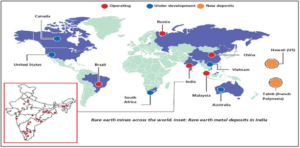Archives
(PRELIMS Focus)
Category: Miscellaneous
Context:
- Venezuela’s Opposition leader María Machado won the Nobel Peace Prize for ‘promoting democracy.’
About Nobel Peace Prize 2025:

- Awardee: Venezuelan Opposition leader María Corina Machado won the Nobel Peace Prize 2025.
- Reason for the award: The Nobel Peace Prize 2025 has been awarded to María Corina Machado “for her tireless work promoting democratic rights for the people of Venezuela and for her struggle to achieve a just and peaceful transition from dictatorship to democracy.”
- Significance: She won the Nobel Peace Prize for her struggle to achieve a democratic transition in the South American nation, winning recognition as a woman “who keeps the flame of democracy burning amid a growing darkness.”
About Nobel Peace Prize:
- Nature: It is one of the five Nobel Prizes established by the will of Swedish industrialist, inventor, and armaments manufacturer Alfred Nobel, along with the prizes in Chemistry, Physics, Physiology or Medicine, and Literature.
- Background: In 1895, Alfred Nobel’s will specified a prize for those promoting fraternity between nations, reducing standing armies, or supporting peace congresses.
- Establishment of the award: The Nobel Peace Prize was established in 1901 by Alfred Nobel, and it recognizes individuals or organisations promoting peace, disarmament, and global harmony.
- Inspiration: Alfred Nobel was inspired by Bertha von Suttner, a peace activist, to include the peace category.
- Awarding Body: The prize is administered by the Norwegian Nobel Committee, elected by Norway’s Parliament (Stortinget).
- First recipient: The first Nobel Peace Prize was awarded in 1901 and was shared by two recipients: Swiss humanitarian Jean Henry Dunant and French pacifist Frédéric Passy.
Source:
Category: Polity and Governance
Context:
- A four-day training to conduct the pre-test exercise for the first phase of the Population Census 2027 has started, the Registrar General and Census Commissioner (RG & CCI) said.
About Census:
- Feature: The Indian Census is the largest source of demographic and socio-economic data on the country’s population.
- First census: India’s first synchronised census occurred in 1881 under W.C. Plowden, the then Census Commissioner of India.
- Decennial in nature: It has consistently provided detailed statistical information every 10 years, starting in 1872, when the first non-synchronous census was conducted across different regions of India.
- Legal framework: The Census Act of 1948 was enacted to create a legal framework for census operations and to define the roles of census officers. While the Act provides the legal framework, it does not mandate a specific frequency, making the decennial pattern a convention, not a constitutional requirement.
- Ministry: In May 1949, the Government of India established a permanent Census organization under the Ministry of Home Affairs to systematize the collection of population and demographic data.
- Implementing authority: The Office of the Registrar General was later tasked with implementing the Registration of Births and Deaths Act, 1969, further expanding its role in maintaining vital statistics.
- About Census 2027:
- The central government has officially notified the conduct of the next decennial census in 2027, exercising its authority under Section 3 of the Census Act, 1948.
- The Census will have a reference date of 1st March, 2027, for most parts of the country.
Source:
Category: Geography
Context:
- An apex committee of the Environment Ministry has accorded a fresh environmental clearance to the Sawalkote hydroelectric project.
About Sawalkote Hydroelectric Project:

- Location: It is a 1,856 MW run-of-the-river (uses the natural flow of a river with little or no water storage) hydroelectric project located on the Chenab River (a western river under Indus Water Treaty) in Ramban, J&K.
- Gravity dam: The project was initiated in 1984 and has faced multiple delays over the years. Declared as a project of national importance, it involves the construction of a concrete gravity dam with a reservoir.
- Electricity production: Once operational, Sawalkote is expected to generate over 7,000 million units of electricity annually, making it one of the largest hydroelectric projects in India.
- Significance: With the Indus Water Treaty (IWT) in abeyance, the project is considered crucial for harnessing Chenab River’s hydropower potential and enhancing India’s control over western rivers of IWT.
About Chenab River:
- Origin: It is formed by the confluence of two streams, Chandra and Bhaga, in the Lahaul and Spiti Districts of Himachal Pradesh. It is a tributary of the Indus River. In its upper reaches, it is also known as the Chandrabhaga.
- Course: It flows through Jammu and Kashmir union territory, Himachal Pradesh and after receiving the Jhelum River near Trimmu, the Chenab empties into the Sutlej River.
- Major Tributaries:
- Left Bank: Niru, Tawi, Neeru, and Liddrari
- Right Bank: Ans, Bhut Nalla, Bichleri, Kalnai Marusudar and Miyar Nalla.
- Major projects on Chenab river: The Chenab River hosts the 390-MW Dulhasti project at Kishtwar, the 890-MW Baglihar project at Ramban, and the 690-MW Salal project at Reasi. These projects significantly contribute to the region’s energy supply.
Source:
Category: Economy
Context:
- US President said that China had sent letters to countries detailing export controls on “each and every element of production having to do with Rare Earths, and virtually anything else they can think of, even if it’s not manufactured in China.”
About Rare Earth Elements:

- Nature: Rare Earth Elements (REEs) are important components in over 200 products, spanning applications in consumer electronics, electric vehicles, defence systems, and many more.
- Types of Rare Earth Elements: Based on the atomic weight, Rare Earth Elements are divided into two groups – light REEs, those with atomic numbers from 57 to 63 (La, Ce, Pr, Nd, Pm, Sm and Eu) and heavy REEs, those with atomic numbers from 64 to 71 (Gd, Tb, Dy, Ho, Er, Tm, Yb and Lu).
- Characteristics: REEs are characterised by high density, high melting point, high conductivity and high thermal conductance. Rare Earth Elements share a trivalent charge (+3) and similar ionic radii, hence similar properties.
- Sources: The principal sources of REE are bastnaesite (a fluorocarbonate which occurs in carbonatites and related igneous rocks), xenotime (yttrium phosphate) commonly found in mineral sand deposits, loparite which occurs in alkaline igneous rocks and monazite (a phosphate).
- Most abundant REE: Cerium is the most abundant rare earth, approximately the same as that of Copper.
- Applications: Rare Earth Elements are very important for futuristic technology. Demand for REEs is expected to rise with a focus on renewable energy, Electric Vehicles, and niche sectors like communications and nuclear energy. They also have wide applications in clean energy, high-end electronics, defence, etc with no equal substitutes.
- Initiatives taken by India:
- Setting up of a Rare Earth Theme Park and joint ventures aim to enhance India’s position in this critical industry.
- RE and Titanium Theme Park was developed by IREL to cater for the technologies developed by BARC.
- India is actively exploring collaborations, and initiatives such as Toyotsu Rare Earths India Limited in Visakhapatnam to enhance efforts to refine rare earths through foreign collaboration.
- IREL processing plants have been established in Ganjam, Odisha and Aluva, Kerala.
Source:
Category: Defence and Security
Context:
- The Indian Army has initiated procurement of the indigenously developed ‘Saksham’ Counter-Unmanned Aerial System Grid System.
About Saksham System:

- Nature: The Situational Awareness for Kinetic Soft and Hard Kill Assets Management (SAKSHAM) is an indigenously developed Counter-Unmanned Aerial System (UAS) Grid System.
- Working: It is a modular, high-end Command and Control (C2) system operating on the secure Army Data Network (ADN).
- Uniqueness: It ensures comprehensive airspace security across the newly defined Tactical Battlefield Space (TBS), which now includes the Air Littoral (airspace up to 3,000 metres, or 10,000 feet, above ground level).
- Objective: The system is designed to detect, track, identify, and neutralise hostile drones and unmanned aerial systems.
- Development: It is developed in collaboration with the Bharat Electronics Limited, Ghaziabad.
- Major features:
- It is designed to detect, track, identify, and neutralise hostile drones and unmanned aerial systems in real time.
- It creates a real-time, integrated Recognised UAS Picture (RUASP) for commanders, merging sensor data, counter-drone systems, and AI-driven analytics.
- It consists of real-time threat detection and AI-enabled predictive analysis, integration of CUAS sensors and weapons for synchronised response, automated decision support and 3D battlefield visualization.
- It can integrate its own as well as hostile UAS data, C-UAS sensors, and soft- and hard-kill systems on a common GIS-based platform.
Source:
(MAINS Focus)
(GS Paper 2: Issues Relating to Health, Government Policies and Interventions)
Context (Introduction)
The death of 24 children in Madhya Pradesh due to a diethylene glycol (DEG)-contaminated cough syrup exposes deep flaws in India’s pharmaceutical regulation, inspection, and accountability mechanisms. The tragedy underscores systemic failures in ensuring drug safety, quality, and monitoring.
Systemic Lapses and Root Causes
- Regulatory Fragmentation: The dual control system under the Drugs and Cosmetics Act, 1940 — with the Central Drugs Standard Control Organisation (CDSCO) approving new drugs and States issuing manufacturing licences — leads to overlap and poor coordination.
- Inspection Deficit: Tamil Nadu’s Sresan Pharma had not been inspected by central regulators for six years, despite norms mandating checks every three years. Over 300 regulatory violations were later found in the factory.
- Quality Testing Failure: Random batch testing and record verification by State Food and Drugs Administrations (FDAs) were neglected. The contaminated batch SR-13 was never sampled or tested before distribution.
- Cost-Cutting and Adulteration: Manufacturers substituted pharmaceutical-grade propylene glycol with cheaper industrial solvent diethylene glycol, a toxic compound used in antifreeze, to reduce costs — a recurring issue in India’s drug contamination history.
- Weak Inter-State Oversight: Once licensed in one State, manufacturers can sell products nationwide without fresh approvals, creating blind spots for importing States such as Madhya Pradesh.
Criticisms and Structural Weaknesses
- Reactive Governance: Investigations began only after multiple child deaths; absence of early warning systems and pharmacovigilance delayed intervention.
- Inadequate Accountability: Suspension of local inspectors and arrests of a single manufacturer mask deeper institutional negligence within both State and Central agencies.
- Recurrent Pattern: Similar DEG-linked deaths occurred in India (1986, 1998, 2020) and abroad (Gambia, Uzbekistan, Indonesia, 2022) involving Indian-made syrups, yet systemic reform remains minimal.
- Information Gaps: No integrated database of licensed manufacturers, recalled drugs, or inspection reports exists, weakening traceability and public transparency.
- Erosion of Trust: India’s pharmaceutical reputation, built on being the “pharmacy of the Global South,” risks reputational damage amid recurring safety lapses.
Reforms and Way Forward
- National Drug Regulatory Authority 2.0: Establish an integrated digital regulatory platform linking CDSCO and all State Drug Control Organisations to monitor licensing, inspection, and recall processes in real time.
- Mandatory Pharmacovigilance Network: Create an adverse drug reaction (ADR) reporting and public alert system covering all hospitals and pharmacies, supported by the Pharmacovigilance Programme of India (PvPI).
- Stronger Quality Infrastructure: Enforce Good Manufacturing Practices (GMP) compliance audits annually; digitise batch-level traceability via QR codes to ensure accountability across supply chains.
- Independent Drug Testing Cadre: Develop regional testing labs under the National Accreditation Board for Testing and Calibration Laboratories (NABL) to prevent reliance on self-reported manufacturer data.
- Public Accountability and Transparency: Mandate public disclosure of inspection reports, violations, and recalls, similar to the US FDA’s “warning letter” system.
Conclusion
The Madhya Pradesh tragedy is not an isolated failure but a systemic one. India’s drug safety architecture must shift from fragmented oversight to a single, transparent, technology-enabled regulatory ecosystem that ensures every medicine sold is genuinely safe and life-saving.
Mains Question:
- Repeated incidents of drug contamination in India point to deeper flaws in pharmaceutical regulation and enforcement. Analyse the structural weaknesses of India’s drug regulatory framework and suggest reforms to restore public trust and safety. (15 marks, 250 words)
Source: https://www.thehindu.com/sci-tech/health/killer-cough-syrup/article70149440.ece
(GS Paper 1: Indian Society – Population and Associated Issues)
Context (Introduction)
India’s announcement of a demographic mission focused on undocumented immigration reignited debate on population governance. Given India’s demographic crossroads — youthful population, migration transitions, and ageing trends — a holistic demographic mission is vital to align population, development, and human capability goals.
Why a Broader Demographic Mission is Needed
- Beyond Population Control: Demography must move beyond fertility and mortality metrics to encompass education, health, and livelihood dimensions that shape human capability.
- Uneven Regional Capabilities: Educational and skill infrastructure remain regionally imbalanced, reinforcing inequities between affluent and underprivileged populations, limiting India’s aspiration to be a global skill hub.
- Migration as a Population Balancer: Internal migration mitigates regional demographic disparities but remains politically and socially stigmatised, despite being constitutionally protected under Article 19(1)(d).
- Ageing and Longevity Transitions: Rising life expectancy demands redefining economically productive years, revisiting pension models, and creating employer-driven savings systems for financial security in old age.
- Demographic Mainstreaming in Policy: Planning and allocation should be guided by population composition rather than crude per capita averages, ensuring that demographic shifts inform welfare priorities.
Criticisms / Drawbacks
- Narrow Policy Vision: India’s demographic debates often remain restricted to population control rather than population utilisation and empowerment.
- Migrants’ Rights Neglected: Both home and host regions disenfranchise migrants, denying them political voice and social belonging.
- Fragmented Institutional Response: No single coordinating framework exists to align demographic realities with employment, health, or education planning.
- Overemphasis on Numbers: The per capita focus overlooks age structure, dependency ratios, and the needs of vulnerable demographic segments.
- Absence of Capability Lens: Policymaking often treats population as burden, not as an asset for development through education and health investments.
Reforms and Way Forward
- Launch a Comprehensive Demographic Mission: A national body should integrate data on fertility, mortality, migration, education, and ageing for region-specific interventions.
- Migrant Inclusion Charter: Ensure voting rights portability and legal protection for internal migrants; promote host–home State coordination mechanisms.
- Human Capability Indexing: Develop region-wise capability metrics combining health, education, and livelihood data to guide budget allocations.
- Ageing Preparedness Strategy: Redefine retirement norms, strengthen old-age insurance, and encourage lifelong skill upgrading for senior citizens.
- Demographic Sensitisation in Governance: Introduce demographic impact assessments in all policies, similar to environmental impact assessments, to mainstream population perspectives.
Conclusion
India’s demographic advantage will endure only if it transforms numbers into capabilities. A holistic demographic mission — integrating youth potential, migrant inclusion, and ageing security — can ensure balanced, inclusive, and future-ready population governance for a humane demographic transition.
Mains Question:
- India’s demographic advantage lies not merely in numbers but in nurturing capabilities and inclusion. Examine the need for a holistic demographic mission that integrates youth potential and ageing preparedness. (15 marks, 250 words)
